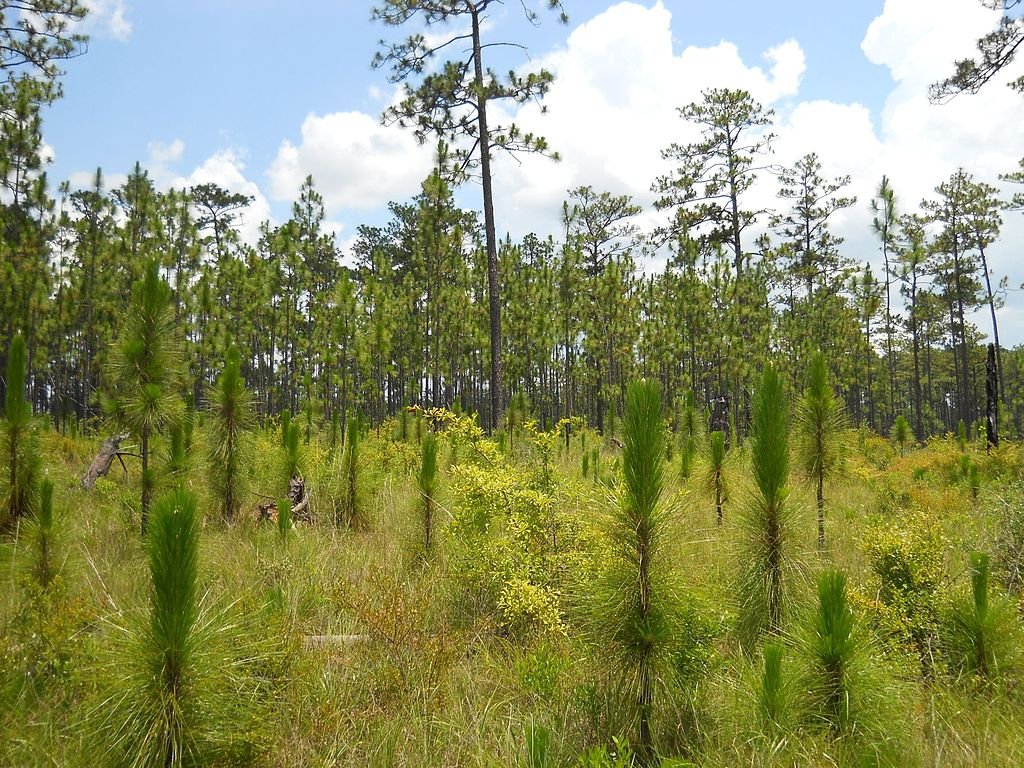The Decline of the Longleaf Pine
Image by Woodlot from WikimediaCommons
Spanning across 90 million acres, longleaf pine trees used to be one of the most abundant pine species in North America prior to colonial times. Due to their value in regards to turpentine and timber, forests were cut down, and now only about 4 million acres of longleaf pine trees remain. With the increase in the population of the United States, forests were cut down to make room for cities and agricultural practices. “Because of this drastic reduction, the forest ecosystem, rather than the tree itself, is considered to be endangered,” (Carter). The longleaf pine supports a myriad of endangered plant and wildlife species like the Gopher Tortoise, Red Cockaded Woodpecker, Gopher Frog, Whitetop Pitcher Plant and Bachman’s Sparrow. Without the protection of the longleaf forest, these creatures will go extinct.
The Southern Longleaf Pine is the state tree of Alabama, and it is characterized by its long, fine needles. Oftentimes, young longleaf pine trees are mistaken for wild grasses due to their short and fluffy appearance, but their reserved height during adolescence increases their resistance to fire, thus allowing them to survive harsh conditions (Carter). Longleaf Pine trees rely on fire in order to reproduce. Fire clears out the underbrush so seeds can reach the soil to germinate (“Longleaf Pine”).
Image by Katja Schulz from Flickr
The decline in the longleaf pine is due partly to the lack of controlled burns in the forest. Without controlled burns, underbrush grows up, and it covers the soil, preventing the longleaf pine seeds from germinating. Fortunately, Reboot Reforestation has developed an extraordinary solution to combat this issue. With the use of seedballs, longleaf pine tree seeds can germinate within their own microclimate without having to reach the underbrush. Some controlled burns will be required to maintain the health of the sapling, however. With proper care, longleaf pine trees can live over 300 years and grow up to a height of 120 ft and a diameter of 2.5 ft (Carter).
Much of the longleaf pine forests’ biodiversity was popularized by famous naturalist and artist William Bartram in the 1700’s (“Southern Longleaf Pine”). Bartram explored the southernmost United States where he cataloged his findings in his scientific journals. He also sent detailed drawings abroad, which fascinated Europeans who bought and sold the depictions of the exotic flora and fauna (Hallock). His drawings featured much of Alabama’s unique biodiversity, and they brought attention to the beauty of Alabama’s natural landscape.
Reboot Reforestation is dedicated to raising awareness about the vast decline of longleaf pine trees. The company’s special seedball technology is making conservation efforts easy and affordable.
Works Cited
Carter, Robert. “Longleaf Pine Forest Ecosystem.”Encyclopedia of Alabama, http://encyclopediaofalabama.org/article/h-1407. Accessed 6 June 2022.
Hallock, Thomas. “William Bartram.” Encyclopedia of Alabama, http://encyclopediaofalabama.org/article/h-1141. Accessed 6 June 2022.
“Longleaf Pine.” nwf.org, https://www.nwf.org/Educational-Resources/Wildlife-Guide/Plants-and-Fungi/Longleaf-Pine. Accessed 6 June 2022.
“Southern Longleaf Pine.” state symbols USA, https://statesymbolsusa.org/symbol/alabama/state-tree/southern-longleaf-pine. Accessed 6 June 2022.

